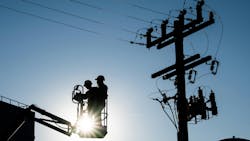How Utilities Are Using AI and Advanced Sensors to Prevent Wildfires
Electric utilities across North America are advancing efforts to reduce wildfire risks with new high-impedance (HiZ) fault detection technology from Eaton. A collaborative initiative involving the U.S. Army Corps of Engineers (USACE) Engineer Research and Development Center (ERDC), the National Renewable Energy Laboratory (NREL), and multiple utilities is testing an innovative approach designed to improve accuracy in identifying and isolating potential fire-starting faults.
High-impedance faults, often caused by fallen trees, broken conductors, or damaged insulators, pose a significant challenge to utilities due to their low fault current levels, which make them difficult to detect using traditional grid protection methods. This limitation has historically led to preemptive public safety power shutoffs in high-risk conditions, disrupting service for communities in wildfire-prone areas.
Recent laboratory tests and pilot deployments have demonstrated a promising new solution that integrates advanced sensors, machine learning, and edge-based implementation to enhance fault detection capabilities. Under simulated conditions using real-world grid data, the technology has achieved over 90% accuracy in identifying and de-energizing hazardous faults. The system is being tested in a range of geographic environments to refine its performance under different environmental conditions.
The initiative's approach to high-impedance fault detection focuses on real-time monitoring and response at the grid edge, a critical need in remote areas with limited communication infrastructure. By incorporating machine learning algorithms trained on extensive datasets—including tree species, soil types, and weather conditions—the technology aims to improve utilities’ ability to detect and mitigate fire risks before they escalate.
Nathan Peterson, an electrical engineer at the USACE ERDC Construction Engineering Research Laboratory (CERL), emphasized the importance of rapid fault detection to protect people, property, and critical infrastructure. "Identifying and responding to fault situations quickly is essential to mitigating wildfire risks. Research and development efforts in this field are creating new opportunities to enhance grid resilience and improve fire prevention strategies," Peterson said.
Utility professionals had the opportunity to learn more about the Eaton HiZ Protect at the 2025 DistribuTECH conference last week.
